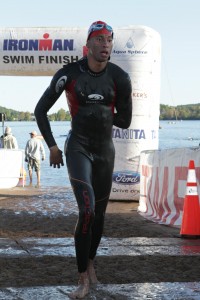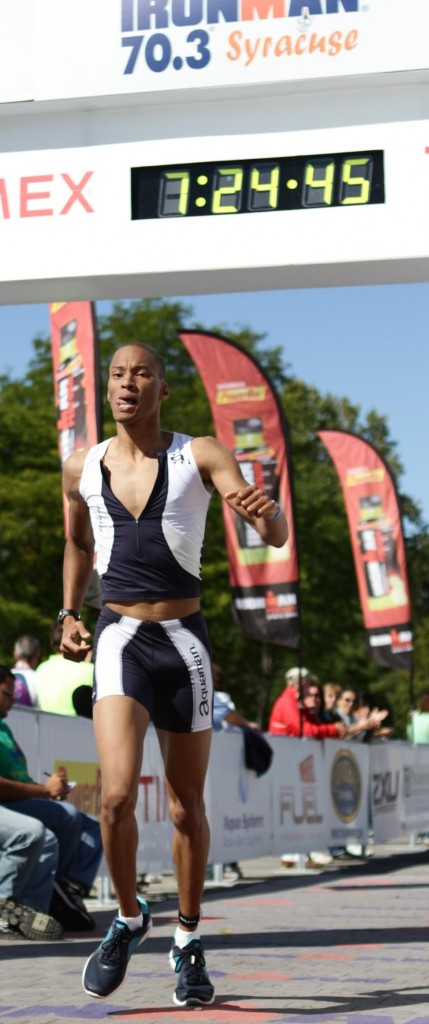by Michelle Sutton-Kerchner
Whether it’s your first competitive run or the esteemed Ironman, appropriate training is essential for success. Trainer John Lancaster shows how to launch into the world of endurance athletics, which for some is just the average hectic day …
Personal Trainer Hits the Road Running( and the Lane Swimming)
It was a desire to swim that sparked Trainer John’s interest in competitive racing. With a background in competitive Muay Thai kickboxing, John was already familiar with the rush of victory. Even more, he already competed in 5K races. A decision to become a swimmer expanded his opportunities and, most importantly, allowed him to continue training.
Trainer Pace Thyself
At 26 years old, John wanted to become an endurance athlete. As a personal trainer, he possessed the knowledge and skill to make this happen. Yet, he hired a trainer to guide him into this new realm of fitness. “When preparing for any sporting event, I always hire a trainer or coach. Even as a personal trainer, I need to rely on another professional to prepare me for my goal,” shares John.
Seeking such guidance equates to using GPS navigation. Although you know how to drive, you often need additional directions on how to reach your specific destination. A copilot can steer you from set-backs, including injuries.
John admits his overzealous training routine came with a price. In only two months, he advanced from running three miles to 13. A combination of excessive training and strenuous workouts hurt his knee. He hit a road block when he could no longer run a mere mile due to knee pain. Fortunately, John’s aspiration to become an endurance athlete coincided with his desire to learn swimming. The knee required rest, so John went to the pool.

There, he hired Swim Instructor and Triathlon Coach Thea Skanes to help prepare for his first triathlon, a Half Ironman. With Thea’s help, he paced himself more appropriately and enjoyed pain-free progress. At the time, he didn’t realize the Half Ironman would be his training for the ING New York City Marathon. From February, when John couldn’t swim a single stroke, to September, John accomplished more than fitness. He learned a life skill: how to swim. In the process, he became a triathlete.
“I needed something to scare me enough to conquer swimming. Preparing for an event that required a distance swim was perfect,” informed John. Not the typical progression taken by those new to swimming and endurance events, John’s method of madness was just what the trainer–and his knee– ordered.
Thea used a unique swim instruction method called total immersion. These lessons teach swimming through balance, relaxation, and swim propulsion techniques. The method yielded efficient results, appropriate for John who allowed only six weeks to train for the triathlon.
“John fit his triathlon training among his work with clients, college courses, and other obligations. Although impressive in what he accomplished, I recommend setting smaller goals so you can proceed slowly and avoid injury. Consider what your lifestyle can manage,” advises Thea. She chuckles, “I’m going to keep a close watch on John’s aggressive training style so he doesn’t re-injure himself.”
For a safe, proper training regimen, Thea suggests the following weekly training commitment for a six-month period:
Triathlon (sprint distance): 5 hours
Triathlon (Olympic distance): 8 to 10 hours
Half Ironman: 12 to 15 hours
Ironman: 20+ hours
Taking an unconventional approach, John used the Half Ironman triathlon to train for his first marathon, the ING NYC. Quite a feat, considering John couldn’t swim across the pool without fear of drowning. (The Half Ironman consists of a 1.2-mile swim, 56-mile bike ride, and 13.1 mile run.) With Thea’s coaching, he remained motivated, building confidence along with skill.

The Half Ironman put John’s new talent to the ultimate test. In September, he swam the required 1.2 miles in 55 minutes. It was his first time swimming beyond the lanes of the Center’s pool. Open, dark water vastly stretched before his eyes as he took to the task that propelled his aspiration to learn swimming.
John claims to feel invincible from the accomplishment. With Thea’s instruction, he developed the confidence to try and the skill to succeed. “It was an exhilarating experience. I can’t wait for the Full Ironman next year,” he remarks. How is he preparing? John already used November’s ING NYC Marathon to begin training for the Full Ironman. He emphasizes a full marathon is only part of the Full Ironman.
A Learning Experience
“I’m taking the Ironman seriously. I’ve already begun training a full year ahead. I don’t want to play catch-up and risk another injury,” assures John. He plans to tackle an ultramarathon in between, which consists of anything over 26.2 miles of running. As a trainer, he recognizes he may be pushing too hard. Yet, fresh off the runner’s high of his last race, he comments, “We’ll see what my body can do.”
John strongly advises members to incorporate aquatic training. “Don’t tear up your joints. Use the pool,” he tells clients. Recently, he encouraged one of his clients to break from the treadmill and train in the water. The variety, with fresh excitement, and water’s buoyancy, with its weightless resistance, allowed his client to go farther. Suddenly, the client’s desire to accomplish a water workout outweighed his reluctance to don a swimsuit.
Through his adventure into endurance events, John feels better able to relate to his clients. “I ask a lot of my clients. Challenging myself in new ways helps me better relate to them.” He mentions two clients he helped prepare for a 5K. “I went with them on their first 5K. I could feel their nerves. I knew the apprehension they were experiencing. That knowledge helped me better motivate them.” He continues, “I’m a better trainer because I live by example.”
An Added Incentive

John also discovered the amazing benefit of dedicating yourself to a cause. With a mother lost to cancer, John made Livestrong (www.livestrong.org) the recipient of his efforts at the ING NYC Marathon. (Livestrong is a nonprofit organization founded by cancer survivor and champion cyclist Lance Armstrong to provide support for those affected by cancer.)
His dedication earned John a wealth of support. He personally raised $3,800, and his team raised $800,000, for Livestrong. John successfully finished the marathon in less than four hours. He realized giving back to the community– by volunteering time, energy, and skill– was an excellent way to enhance his own well-being.
Worthy-cause fitness events are great motivators. They act as “deadlines” for your exercise routine. They provide specific goals and target dates for meeting them. With the commitment to Livestrong, John added inspiration to take himself to the next level. When competing for a cause, you become aware of the power your body truly yields. Best yet, you appreciate and improve your own health while improving the lives of others.
The Center often offers opportunities to participate in community fitness events that help worthy causes. Consider adding a new dimension to your workout by trying one .
As a trainer, endurance athlete, and new swimmer, John urges, “Be strong. Fearlessly go after your goals, whatever they may be.”
“When I dare to be powerful —to use my strength in the service of my vision, then it becomes less and less important whether I am afraid.” (Gratefulness.org)
 Fitness & Wellness News Your Source for Fitness News, Wellness News, Health News, and Nutrition News!
Fitness & Wellness News Your Source for Fitness News, Wellness News, Health News, and Nutrition News!



